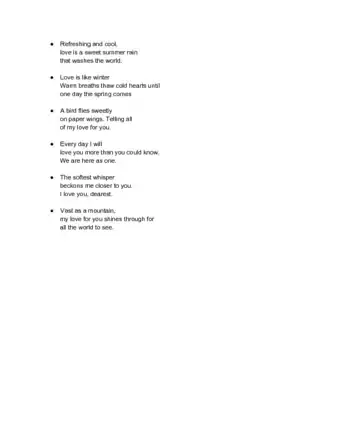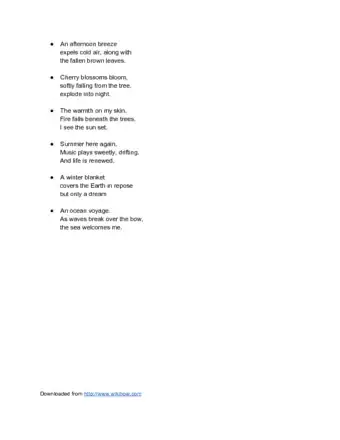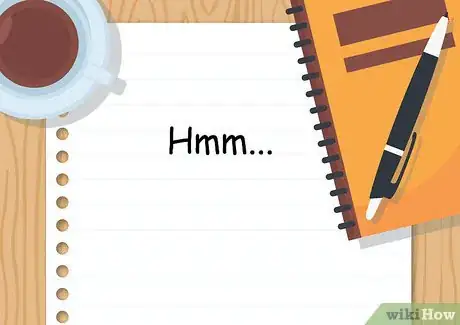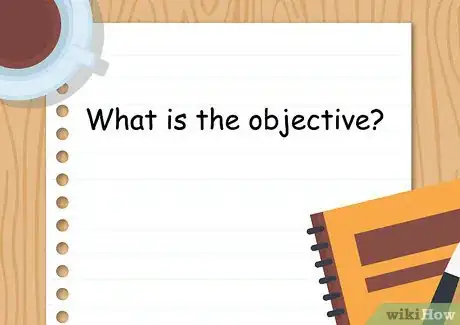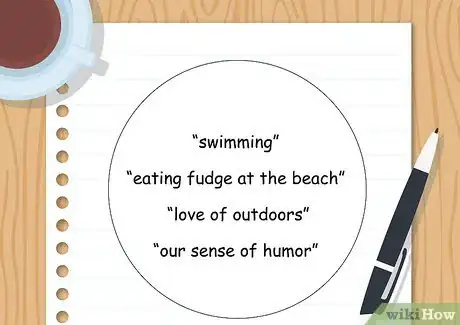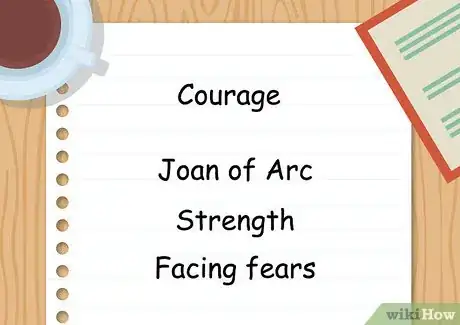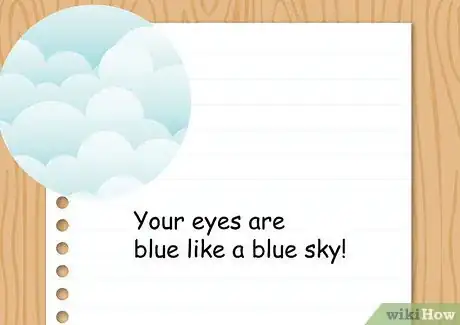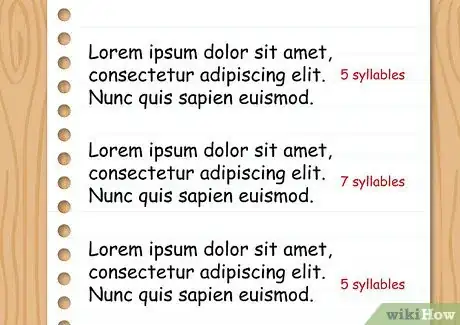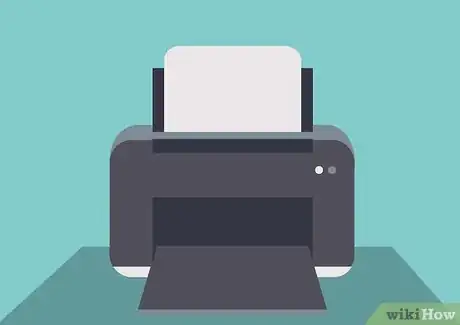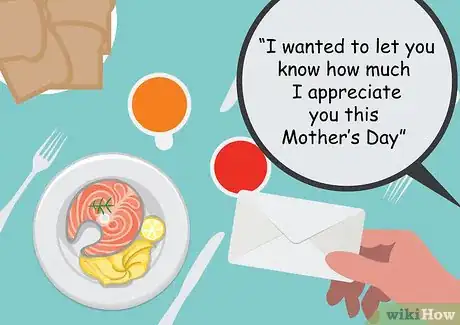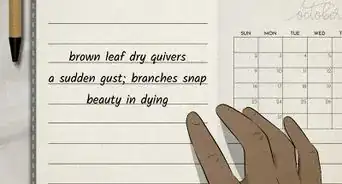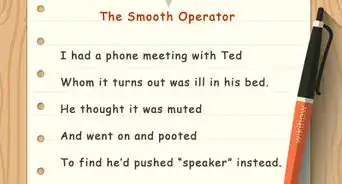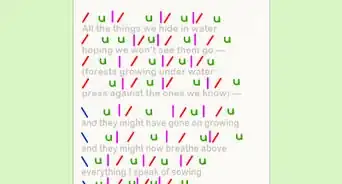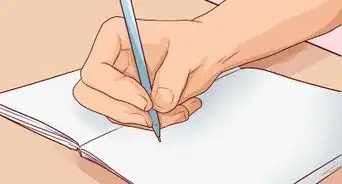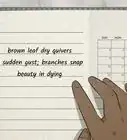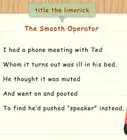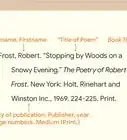This article was co-authored by wikiHow Staff. Our trained team of editors and researchers validate articles for accuracy and comprehensiveness. wikiHow's Content Management Team carefully monitors the work from our editorial staff to ensure that each article is backed by trusted research and meets our high quality standards.
This article has been viewed 65,544 times.
Learn more...
Haiku are a form of Japanese poetry, which have three lines and a 5-7-5 syllable structure. Because haiku are simple poems, they are a great way of expressing your feelings about someone. By becoming familiar with haiku, thoughtfully selecting a person to write about and carefully crafting your poem, you can be sure to create a haiku your recipient will cherish.[1]
Steps
Sample Haiku
Brainstorming about Your Subject
-
1Select the person you’re composing the haiku for. Is this a poem for your mom for Mother’s Day? Or are you confessing your love to your best friend? Take a moment to identify the person who will be the subject of your writing, presumably also the person who will also receive the finished haiku.[2]
- If you’re having trouble picking a subject, it can be helpful to pick someone close to you like a member of your family or a best friend.
-
2Keep a goal in mind as you’re writing. What is the objective of composing your haiku? Are you aiming to show overall affection or ask someone to go on a date? Keep your end goal in mind as you embark upon the writing process to ensure that your poem addresses what you hope to convey.
- Haiku are often inspired by a particularly poignant moment or experience. Effective haiku condense a lot of sentiment and information in very few words.
Advertisement -
3Make a word cloud about your subject. Before you actually start writing the haiku, you’ll need to get your feelings and ideas flowing. Try making a word cloud to begin accessing your deeper thoughts. You can write down ways the person makes you feel, important things you’ve done together or hobbies you share. For example, “swimming,” “eating fudge at the beach,” “love of outdoors,” or “our sense of humor.”
- Some websites online can form a digital word cloud for you, if you’re having trouble doing it on your own. You can input text from some of your favorite correspondence into the word-cloud engine to see what words crop up frequently. [3]
-
4Make word associations to build on your poetic theme. What words come to mind when you consider the theme of the poem? These words can be things you associate with the theme because of a memory or just ideas that echo one another. Make a short list to flesh out your poetic idea more fully.
- If you want to write about why your sister is so courageous, for example, make a list of words and ideas around the theme of courage. So for your sister you might write down, “Joan of Arc,” “strength,” “facing her fears,” and “leap of faith.”
Crafting the Poem
-
1Use words from your word cloud to form sentences. Once you’ve made a word cloud that encompasses some of your thoughts and memories surrounding your recipient, it’s time to begin writing. Compose some basic sentences based on the feelings you’ve brought forward. For example, “Your eyes are blue like a swimming pool,” or “I love laughing with you in the woods.”
- Don’t be too critical of yourself at this point in the process. Your ideas aren’t fully formed just yet. It won’t all sound like poetry yet!
- If you’re searching for some central point around which to focus your poem, look at all your sentences. Are they all about hiking together or playing at the beach? It can help to group similarly themed ideas together.
- There’s no need to count syllables yet. You will work on that later in the process.
-
2Distill the information. Now that you’ve crafted a few sentences about your subject, it’s time to make them less prosaic and more poetic. To make your sentences more poetic, see if there is, at once, both a more simple and descriptive way to say something.[4]
- For example, think about the sentiment behind your sentences. Behind, “your eyes are blue like a swimming pool,” you’re really trying to say that your recipient’s eyes remind you of water. A more poetic and succinct way to say that would be, “Your eyes, a vast sea.”
- Use this technique to create three thematically related lines of poetry; don’t worry about the syllables just yet.
-
3Tinker with your lines to adhere to the 5-7-5 syllable structure. The hallmark of the haiku form is the syllable structure. The first line has five syllables. The second line has seven syllables. And the last line has five syllables again.
- If you have trouble counting syllables, place your hand under your chin. Read a given line. Your mouth will generally drop with every syllable. So every time your mouth drops and hits your hand, count that as one syllable. It may be helpful to write the number of syllables you currently have in each line at the end of the line.
- If you need to trim words to get to the right syllables count, try cutting articles and adverbs, which can weigh down poetry. If you need to inflate the number of syllables, adding a descriptive adjective can help.[5]
- For example, “Your eyes, a vast sea,” could become “Your eyes, a vast turquoise sea.” The adjective turquoise helps the line reach seven syllables and adds meaning.
- For example, “Swimming quickly is a joy,” can be cut down to five syllables easily by removing the adverb quickly, which is not adding much meaning.
-
4Reread your work to ensure it conveys the message you were hoping for. When you’ve completed your work, review the entire haiku to ensure it matches up with what you set out to do. If you’re using the haiku to ask someone to prom, for example, does it actually ask the question and accomplish that goal? If you’re using the haiku to tell your mother how much you love her, does some version of mom or mother appear, so she knows it’s about her?
- If your haiku doesn’t accomplish your objective yet, don’t panic! Just go back to tinkering with your syllables. Perhaps you can swap out a word or two to make your message clearer. Haiku are short, so even changing one word can have a big impact on the final poem.
Giving Your Finished Haiku to Your Recipient
-
1Print your Haiku out on nice paper. Haiku are a timeless art. You can of course send your finished haiku over email, but for more impact, consider printing your haiku on nice paper so it can be saved as a keepsake. Your recipient will be more likely to cherish it for years to come.
-
2Find a good time to meet with your subject. It’s hard for someone to appreciate a gift as thoughtful and time-filled as a haiku if you catch them at an inopportune moment. Ask your recipient to lunch or find a quiet time where they are not distracted for your poem to have the most impact.[6]
-
3Relay your message verbally when gifting your haiku. Haiku are very personal gifts one doesn’t receive every day. To ensure the message behind your haiku comes through, you could say, “I wanted to let you know how much I appreciate you this Mother’s Day,” or “I wanted to ask you to prom on Saturday.”
Community Q&A
-
QuestionWhy is the traditional way to write a haiku to use three lines and five, then seven, then five, syllables?
 Rachel VACommunity AnswerThe 5-7-5 rule is only somewhat true. As per both NaHaiWriMo (National Haiku Writing Month) and Wikipedia, Japanese "syllables" are counted differently. While the traditional Japanese method consists of 17 "on" (a short syllable, or sound). These "on" are counted per mouth sound. An example of the differences would be the letter "n." If it appears at the end of a word, it's a separate syllable. A full explanation can be found on the NaHaiWriMo article "Why no 5-7-5," as well as the Wikipedia article "Haiku" (subsection "Syllables or 'On' in Haiku"), or the article "'On' (Japanese prosody)."
Rachel VACommunity AnswerThe 5-7-5 rule is only somewhat true. As per both NaHaiWriMo (National Haiku Writing Month) and Wikipedia, Japanese "syllables" are counted differently. While the traditional Japanese method consists of 17 "on" (a short syllable, or sound). These "on" are counted per mouth sound. An example of the differences would be the letter "n." If it appears at the end of a word, it's a separate syllable. A full explanation can be found on the NaHaiWriMo article "Why no 5-7-5," as well as the Wikipedia article "Haiku" (subsection "Syllables or 'On' in Haiku"), or the article "'On' (Japanese prosody)."
References
- ↑ https://www.poets.org/poetsorg/text/haiku-poetic-form
- ↑ http://www.readwritethink.org/classroom-resources/printouts/haiku-starter-30697.html
- ↑ http://www.wordclouds.com/
- ↑ http://www.writersdigest.com/writing-articles/by-writing-genre/poetry/literary_alchemy_turning_your_prose_into_poetry
- ↑ http://www.writersdigest.com/editor-blogs/guide-to-literary-agents/subverting-adverbs-and-cliches
- ↑ https://www.psychologytoday.com/blog/unthinking/201104/whens-the-best-time-get-yes
